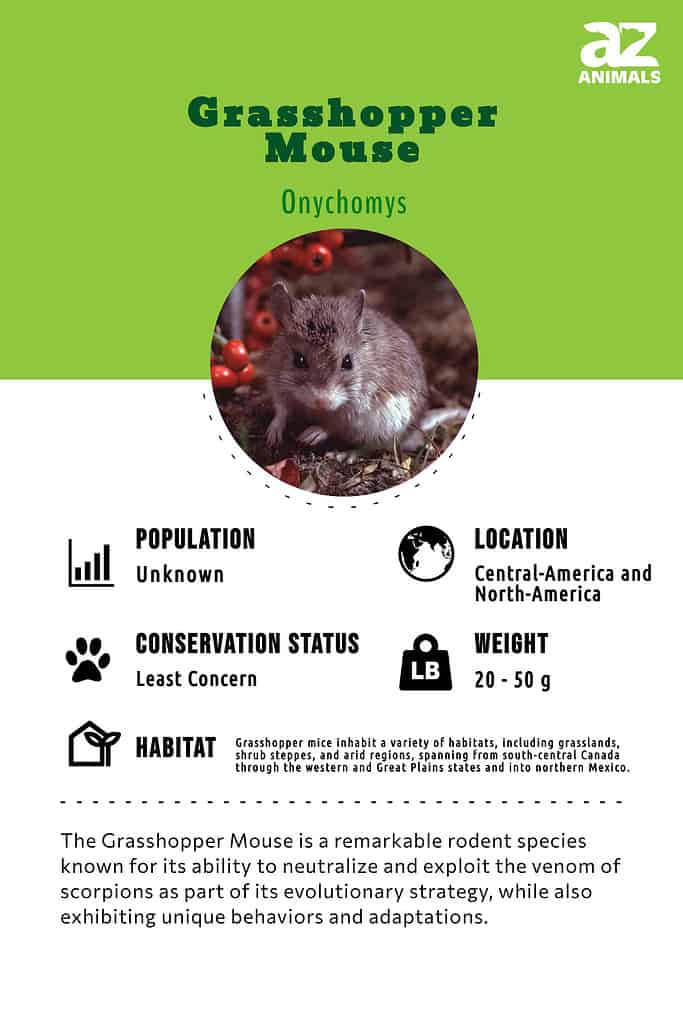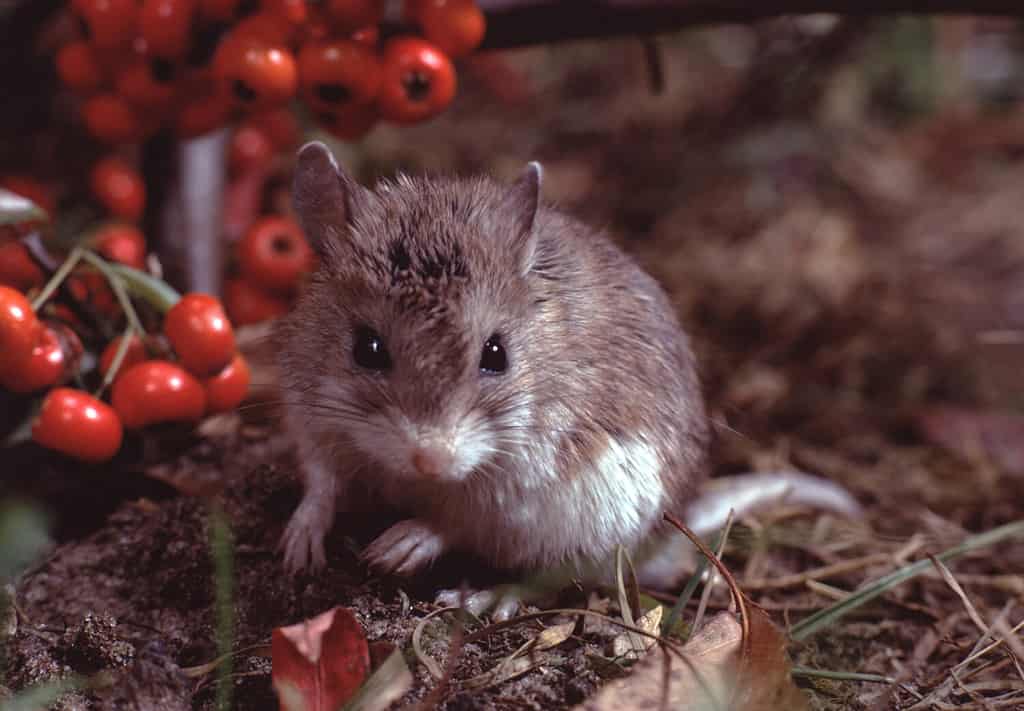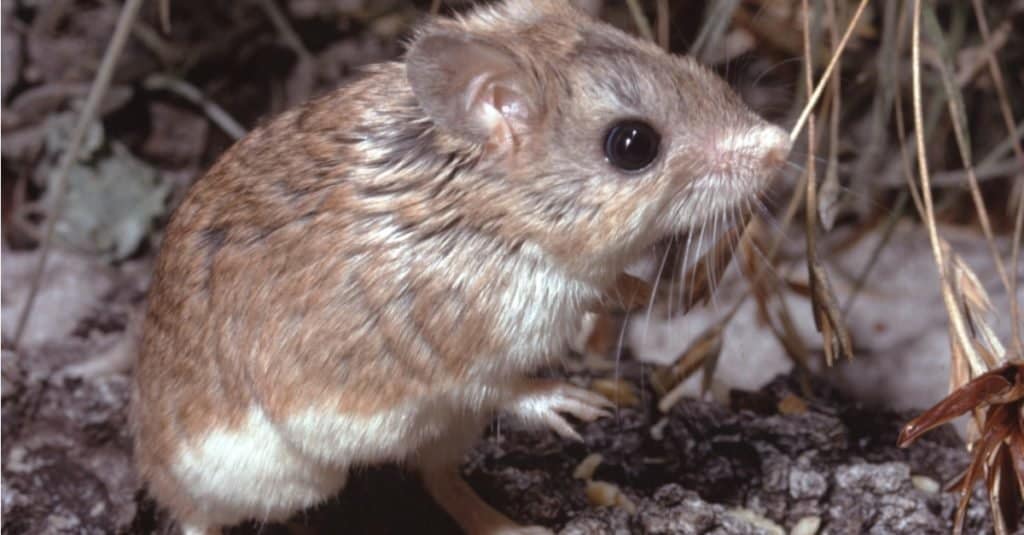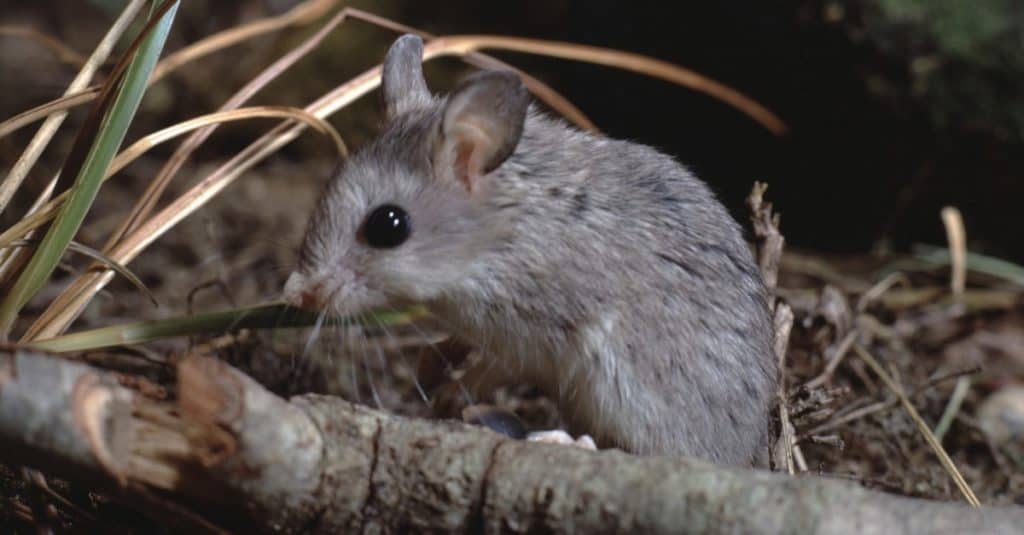Grasshopper Mouse
The grasshopper mice attack predators using the poison of their venom.
Advertisement
Grasshopper Mouse Scientific Classification
Read our Complete Guide to Classification of Animals.
Grasshopper Mouse Conservation Status
Grasshopper Mouse Facts
- Prey
- Scorpions, insects, grasshoppers, crickets, and kangaroo rats
- Name Of Young
- Kitten, pinkie, or cub
- Group Behavior
- Mainly solitary
- Fun Fact
- The grasshopper mice attack predators using the poison of their venom.
- Estimated Population Size
- unknown
- Biggest Threat
- Owls, birds, and humans
- Most Distinctive Feature
- Furry bodies and sometimes fat tails
- Gestation Period
- 26 to 35 days
- Litter Size
- 2-6, though most litters are just 4 pups
- Habitat
- Grasslands, elevated areas, and deserted scrubs
- Diet
- Carnivore
- Type
- Rodent
- Common Name
- Grasshopper mice
- Number Of Species
- 3
- Location
- Canada, Mexico, California
Grasshopper Mouse Physical Characteristics
- Color
- Grey
- White
- Gold
- Pink
- Skin Type
- Fur
- Lifespan
- The lifespan is only about a few weeks or months in the wild
- Weight
- 20 to 50 grams
- Height
- Body - 3.5 to 5 inches, tail – 1 to 2.5 inches
- Length
- Body - 3.5 to 5 inches, tail – 1 to 2.5 inches
- Age of Sexual Maturity
- Approximately 3-4 months old
- Age of Weaning
- 3 weeks
View all of the Grasshopper Mouse images!

Grasshopper mice are rodents with big ears and big eyes. They are nocturnal and are closely related to deer mice.
They are small and are usually only 120-190 mm in length. Adult grasshopper mice weigh about 20 to 50 grams.
They got this name because they are not timid as mice usually are and are known to be ferocious. They are carnivores and feed on other living creatures.
There are 3 types of grasshopper mice – southern grasshopper mice, northern grasshopper mice, and Mearn’s grasshopper mice.
These rodents make howling sounds just before they are about to kill their prey.
5 Incredible Grasshopper Mouse Facts

Three distinct varieties of these mice exist southern grasshopper mice, northern grasshopper mice, and Mearn’s grasshopper mice.
©Liz Weber/Shutterstock.com
Here are some interesting facts about these mice:
- Some of these mice are only about the size of a pencil.
- There are 3 types of these mice – southern grasshopper mice, northern grasshopper mice, and Mearn’s grasshopper mice.
- These mice are fairly very aggressive predators.
- They have at least 6 vocalization sounds to communicate with each other.
- Grasshopper mice have an impressively high pain tolerance.
Evolution and Origins
Evidence of their lineage can be traced in the geological records of North America as far back as the early Pliocene Epoch, which occurred approximately 5.3 to 3.6 million years ago, and their closest living relatives are deer mice.
The distribution of the Northern Grasshopper Mouse (Onychomys leucogaster) spans from south-central Canada through the western and Great Plains states, extending into northern Mexico, with its range reaching the far northeastern periphery in western Minnesota within the Prairie Parkland Province.
In a captivating example of an evolutionary arms race, the grasshopper mouse has developed a unique adaptation that not only neutralizes the typically painful venom of its primary prey, the scorpion but also generates a pain-relieving effect, effectively turning the scorpion’s venom into an advantage.
Scientific Name

The scientific name for these mice is Onychomys.
©iStock.com/Weber
These mice go by the scientific name Onychomys. They belong to the kingdom Animalia. The phylum is Chordata and the class is Mammalia and the order is Rodentia and the family Cricetidae and the subfamily is Neotominae. Their tribe is called Reithrodontomyini and the genus is also called Onychomys.
Onychomys is a combination of the Latin words onych- and -mys. “Onych” is a combination of words to mean a fingernail or toenail, while the suffix “mys” literally means “mouse.”
Appearance

These mice possess plush and compact fur that is characterized by a grayish-brown to reddish-brown coloration, while their bellies typically exhibit a striking white hue, creating a noticeable contrast.
©iStock.com/Weber
These mice have a silky and dense coats. Their belly is often white, offering a stark contrast to the rest of their coat (which is greyish-brown to reddish-brown). Usually endemic to Mexico and the United States of America, the southern grasshopper mice have a size of about 3.5 to 5 inches while the tail is about 1.0 to 2.5 inches long.
Meanwhile, the Mearn’s grasshopper mice are small in size but have a fat tails. Their tails make up more than 1/3rd of the entire mouse.
In Southern grasshopper mice, females tend to be heavier as well as larger than their male counterparts. Their brain sizes also differ. The brain size of a grasshopper mouse depends on the food preferences that the mouse has. It is believed that the brains of folivores are the smallest, while the brains of granivores and insectivores are somewhat larger, and that the brains of generalists are the largest.
Behavior

Northern Grasshopper mouse looking for prey.
©Liz Weber/Shutterstock.com
These mice are nocturnal creatures. Some of them are extremely aggressive predators, intelligently going after their prey without mercy. To communicate with others, they have 6 different vocalization types.
Their communication kind and frequency depend from species to species and are distinguishable between sex and age. It is said that the larger grasshopper mice tend to have a deeper voice.
If and when the mouse feels attacked, it will let out a loud screech voice or a bark. These rodents tend to be active all year round and are often good climbers.
These mice have for years coevolved and coexisted with the bark scorpions. The bark scorpion paralyzes other animals by injecting venom through their spikes into the other animal’s bodies. Over time, the grasshopper mice have been able to develop a certain level of pain tolerance so that the venom of the scorpions does not affect them as much now.
These mice make a howling sound right before they are about to kill their prey. This sound usually pierces through quiet nights. They can also make this sound when they spot another like them but they often howl just before they kill their prey.
The Southern grasshopper mice are prone to indulge in cannibalism acts as they can often kill and eat the members of their species if the food is scarce. Usually, they are solitary animals, but they’ll stay with a partner when they need to breed and have a new litter. They can reproduce all year but it is more likely to happen during some months. Sometimes, one of the partners also kills the other.
Habitat

The habitat of the northern grasshopper mice encompasses grasslands and shrub steppes, spanning from Central Canada and extending southward through the Great Plains and Great Basin regions until reaching northern Mexico.
©iStock.com/Weber
The northern grasshopper mice live in grasslands and shrub steppes all along with Central Canada southward through the Great Plains and Great Basin to northern Mexico. Meanwhile, the southern grasshopper mice are found all along southern California, Nevada, and Utah southward to northeastern Mexico.
Some of these mice are found living in shortgrass prairies and desert scrubs. They often prefer areas with low elevations and have a range of about 2 to 3 hectares. They are found to exist in low densities often.
Diet
These mice might be small in size but most of them are very aggressive predators. They are also very sophisticated predators and often bite off their prey at their heads.
Their diet usually consists of insects, beetles, grasshoppers, crickets, and scorpions. However, their diets are not limited to only these creatures. They also stalk as well as kill and eat other small rodents such as Kangaroo rats, voles as well as white-footed mice.
The southern grasshopper mice will kill each other if the food is scarce. They usually live in pairs, though one of the partners can end up killing the other as food in times of extreme hunger. They do indulge in acts of cannibalism.
Predators and Threats
These mice, despite their small size, do not have too many predators. Owls and other nocturnal birds of prey usually feed on these rodents.
Even snakes, centipedes, and scorpions also do not consume these mice as they are often known to be prone to venom and are difficult to catch hold of.
However, human activities do have an impact on the habitat of the mice. Other potential threats include urbanization and industrialization by humans.
In the wild, these mice may live only for a few weeks to a few months.
Resistance to Poison
These deceptively cute rodents with a penchant for aggression are rather fond of taking on prey that would make other predators’ hearts quail. Centipedes, bark scorpions, and snakes which have a reputation for attacking and defending themselves with venom are a regular fixture on these diminutive mammals’ menu. How do they avoid those poisonous jabs and avoid ending up as dinner in some cases?
The key lies in their resistance to venom and their agility.
Scientists have discovered that the nerve which detects pain in grasshopper mice does not transmit any alarm signals in the event of the rodents being stung by bark scorpions.
This, they assert, is due to the ability of the mammals to switch off their pain pathways following a sting.
Munching on a centipede is merely a simple matter of nimbly avoiding those venomous fangs and darting in for a bite of chitinous exoskeleton until the arthropod is overcome.
Reproduction and Life Cycle
These mice are capable of reproducing all around the year. However, in the northern grasshopper mice, reproduction happens usually between May and October. The males and females come in close proximity of about 10 to 15 centimeters of each other and begin to smell the anal area of the other sex.
The male then follows the female until he mounts her from the rear into a copulatory lock. This process occurs in 10 phases and usually takes about 3 to 4 hours to complete.
Each phase is completed once the female moves away and grooms herself. The female usually gives birth to 4 babies and usually cares for them until they are about 14 days old. The males do not contribute to caring for the babies. The females give birth to several litters per year.
The gestation period in southern grasshopper mice lasts for about 26 to 35 days. The females that are born in April might be ready for reproduction early and could produce 2 to 3 litters of babies before the year ends. Their litter size could be 2 to 6 babies. The babies open their eyes at 2 weeks of age. Once they reach sexual maturity, females seldom breed after 2 years.
Population
While the exact population numbers are difficult to procure when it comes to these mice, it is a well-known fact that there are 3 different types of this particular rodent. So, it is expected that there are enough of these mice around the world. There is also no threat to their population and they do fall into the least concern category.
View all 170 animals that start with GGrasshopper Mouse FAQs (Frequently Asked Questions)
Why does the grasshopper mouse howl?
Grasshopper mice usually howl when they spot prey. This howling is a screeching noise that pierces through the otherwise quiet night and can also mean that the mouse has come across another of its kind. But usually, it is just before these mice are ready to kill their prey.
What is unique about the grasshopper mouse?
These mice howl before they kill their prey and uniquely, they have a high pain tolerance and are prone to venom which is why most poisonous predators do not eat them.
Can you keep a grasshopper mouse as a pet?
Keeping them as a pet is possible as these rodents can trust human beings and coexist with them through time, it is generally not advisable to keep them as a pet.
Is grasshopper mouse immune to venom?
Yes, the grasshopper mice are immune to venom. This is why they are not eaten by most predators. Their evolutionary traits allow them to use this venom to their advantage, eating that predator instead.
Thank you for reading! Have some feedback for us? Contact the AZ Animals editorial team.
Sources
- Current Biology / Accessed May 30, 2021
- Britannica / Accessed May 30, 2021
- Wikipedia / Accessed May 30, 2021
- Animal Diversity Web / Accessed May 30, 2021


















